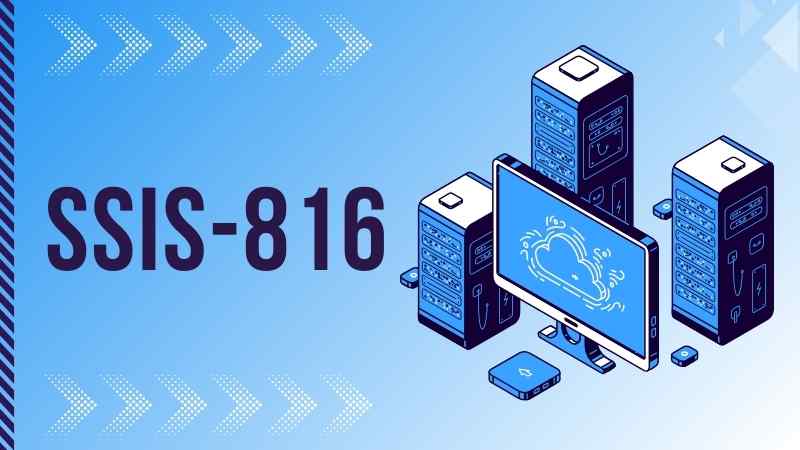Understanding SSIS-816: A Comprehensive Overview of Key Features
Introduction
SSIS-816 is a significant advancement in data integration. Understanding its key features and functionalities can drastically improve how organizations manage and transform their data. In this article, we’ll delve into the essential aspects of SSIS-816, from its definition and key features to installation tips and performance improvements. Whether you’re a seasoned data professional or new to SSIS, this comprehensive guide will provide valuable insights.
Overview of SSIS
What is SQL Server Integration Services (SSIS)?
SQL Server Integration Services (SSIS) is a powerful data integration and workflow automation tool developed by Microsoft. It allows users to extract, transform, and load (ETL) data from various sources into a data warehouse or other target systems. SSIS supports many data sources and destinations, making it a versatile choice for many data integration scenarios.
Key Components of SSIS
The core components of SSIS include:
- Control Flow: Manages the execution of tasks and workflows.
- Data Flow: Handles the extraction, transformation, and loading of data.
- Event Handlers: Manage and respond to events during package execution.
- Package Explorer: Provides a graphical interface for designing and managing packages.
SSIS-816 Explained
Definition and Purpose
SSIS-816 is a specific version of SSIS that introduces several enhancements and new features. It aims to improve data integration processes, performance, and error-handling capabilities. Understanding these features is crucial for effectively leveraging SSIS-816.
Key Features of SSIS-816
Enhanced Data Flow
SSIS-816 introduces improvements to the data flow engine, allowing more efficient data processing. Enhanced data flow components ensure smoother transitions between various stages of data integration.
Improved Performance Metrics
Performance metrics have been significantly upgraded in SSIS-816. These improvements include faster execution times and reduced resource consumption, improving overall performance.
New Transformation Options
SSIS-816 offers new transformation options that provide greater flexibility in data manipulation. These new options allow for more complex data transformations and enhance the ability to tailor processes to specific needs.
Advanced Error Handling
One of the standout features of SSIS-816 is its advanced error-handling capabilities. It provides more detailed error messages and improved data integration mechanisms for managing and resolving issues.
Installation and Configuration
System Requirements
Before installing SSIS-816, ensure your system meets the following requirements:
- Operating System: Windows Server 2016 or later, Windows 10 or later
- SQL Server Version: SQL Server 2019 or later
- Hardware: Minimum of 8 GB RAM, 4 CPU cores
Step-by-Step Installation Guide
- Download SSIS-816: Obtain the installer from the official Microsoft website.
- Run the Installer: Follow the on-screen instructions to begin the installation.
- Configure Settings: Choose the appropriate configuration options based on your system and requirements.
- Complete Installation: Finish the installation and restart your system if prompted.
Configuration Tips
- Use Default Settings: For most installations, the default settings are sufficient.
- Allocate Resources Wisely: Ensure adequate resources are allocated to support SSIS-816’s enhanced features.
Features of SSIS-816
Enhanced Data Flow
The data flow improvements in SSIS-816 are designed to handle larger volumes of data more efficiently, resulting in faster data processing and reduced latency.
Improved Performance Metrics
SSIS-816’s performance enhancements include better execution times and optimized resource usage. These improvements are measurable through detailed performance metrics, which can be monitored using SQL Server Management Studio (SSMS).
New Transformation Options
The introduction of new transformation options allows for more intricate data processing. These options enable users to perform complex transformations that were previously difficult or impossible.
Advanced Error Handling
SSIS-816’s advanced error-handling features provide more detailed insights into errors. This includes enhanced logging and error reporting, which simplifies troubleshooting and resolution.
SSIS-816 and Data Integration
Role in Data Integration
SSIS-816 plays a crucial role in streamlining data integration processes. Its advanced features facilitate efficient ETL operations, ensuring that data is processed accurately and promptly.
Benefits of ETL Processes
The benefits of SSIS-816 for ETL processes include:
- Improved Performance: Faster data processing and reduced execution times.
- Enhanced Flexibility: More options for transforming and manipulating data.
- Better Error Management: Advanced error handling and troubleshooting capabilities.
Performance Improvements
Performance Metrics and Benchmarks
SSIS-816 offers significant performance improvements over previous versions. Benchmarks show faster execution times and lower resource consumption, contributing to overall efficiency.
Comparison with Previous Versions
Compared to earlier versions of SSIS, SSIS-816 delivers superior performance and enhanced functionality. These improvements make it a valuable upgrade for organizations looking to optimize their data integration processes.
Error Handling and Troubleshooting
Common Issues
Some common issues with SSIS-816 include:
- Installation Errors: Problems during installation can usually be resolved by verifying system requirements and configuration settings.
- Performance Bottlenecks: Performance issues can often be addressed by optimizing data flow configurations and resource allocation.
Best Practices for Error Handling
- Use Detailed Logging: Enable detailed logging to capture comprehensive error information.
- Implement Retry Logic: Configure retry mechanisms to handle transient errors effectively.
Troubleshooting Tips
- Check Error Logs: Review error logs to identify and resolve issues.
- Consult Documentation: Refer to SSIS-816 documentation for guidance on common problems and solutions.
Security Features
Data Security Enhancements
SSIS-816 includes several enhancements to data security, including improved encryption and secure data transmission features. These improvements help protect sensitive information during integration processes.
Authentication and Authorization Improvements
SSIS-816 also offers enhanced authentication and authorization features, ensuring only authorized users can access and manage data integration tasks.
Compatibility and Integration
Supported Platforms
SSIS-816 is compatible with a range of platforms, including:
- Windows Server 2016 and later
- Windows 10 and later
Integration with Other SQL Server Components
SSIS-816 integrates seamlessly with other SQL Server components, such as SQL Server Analysis Services (SSAS) and SQL Server Reporting Services (SSRS). This integration enhances overall data management and reporting capabilities.
Case Studies and Use Cases
Real-World Applications
Organizations across various industries have successfully implemented SSIS-816 to streamline their data integration processes. Case studies highlight its effectiveness in improving performance, flexibility, and error handling.
Success Stories
- Retail Sector: A significant retailer used SSIS-816 to enhance its ETL processes, resulting in faster data processing and improved inventory management.
- Healthcare Industry: A healthcare provider leveraged SSIS-816 to integrate patient data from multiple sources, improving data accuracy and reporting capabilities.
Best Practices for Using SSIS-816
Optimization Techniques
To maximize the benefits of SSIS-816, consider the following optimization techniques:
- Optimize Data Flow Configurations: Fine-tune data flow settings to improve performance.
- Monitor Performance Metrics: Regularly review performance metrics to identify and address potential issues.
Common Mistakes to Avoid
- Neglecting Error Handling: Failing to implement robust error handling can lead to data integration issues.
- Overlooking Performance Tuning: Not optimizing data flow configurations can result in suboptimal performance.
Future Trends and Updates
Upcoming Features
Future updates to SSIS may include additional features and enhancements, such as improved cloud integration and advanced analytics capabilities.
Industry Trends in Data Integration
The field of data integration is evolving, with trends such as increased cloud adoption and the integration of machine learning and AI technologies. Staying informed about these trends can help organizations leverage SSIS effectively.
Conclusion
In summary, SSIS-816 represents a significant advancement in data integration technology. Its enhanced features, improved performance, and advanced error-handling capabilities make it a valuable tool for organizations looking to optimize their data integration processes. By understanding and leveraging these features, businesses can achieve more efficient and accurate data management.
FAQs
What is the primary benefit of SSIS-816?
The primary benefit of SSIS-816 is its enhanced performance and advanced features, which improve data processing efficiency and error handling.
How does SSIS-816 improve performance?
SSIS-816 improves performance through faster data processing, reduced resource consumption, and optimized data flow configurations.
What are the common issues with SSIS-816?
Installation errors and performance bottlenecks are common issues, which can often be resolved through detailed error logs and performance optimization.
How do I integrate SSIS-816 with other SQL Server components?
SSIS-816 integrates seamlessly with other SQL Server components, such as SSAS and SSRS, enhancing overall data management and reporting capabilities.
Where can I find additional resources on SSIS-816?
Additional resources on SSIS-816 can be found in official Microsoft documentation, online forums, and industry publications.














Post Comment